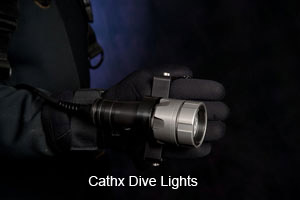Lights for Public Safety Diving

So when we consider what kinds of lights are appropriate for PSD – especially given that the vast majority of dives are in conditions where no light could improve visibility – let’s put aside wide beam vs. narrow beam, rechargeable vs. standard battery, HID vs. LED, candlepower vs. lumens and consider a few factors that may not have been previously addressed.
One consideration is the decision to have hands-free operation or the traditional hand-held light. While some of the decision making process will depend on available budget, there are a number of options available from several manufacturers. In addition to the hand bracket, popularized by the cave diving community which allows a light head to be mounted on the back of the hand allowing use of the hand, there are also mounting options utilizing rail systems or mounting brackets that can be installed on full face masks or fully enclosed dive helmets. These light heads may be powered by separate battery containers connected by cord or may be a completely contained light including battery power. This option is available for hand brackets as well.
Another over-looked feature to consider is, “do we need a light that is safety rated or explosion proof?” While at first glance this may seem unimportant or irrelevant, consider this: often smaller hand-held lights that are used underwater are also used topside by tenders and other team personnel. Given that any call can potentially result in a scene with flammable material present, perhaps it should be a consideration to have smaller handheld underwater lights that are at a minimum Class 1 rated. For law enforcement PSD’s, Class 1 safety rating essentially means the light can be safely used in environments where flammable gases, vapors or liquids are present. Often these lights provide a narrow beam that is useful for not only cutting through smoke but also turbid water.
When purchasing underwater lights, it’s quite normal to be confused by some of the descriptions used as they relate to how powerful or bright the light is. Two terms used are “candlepower” and “lumens.” Both refer to candela which measures the power emitted by a light source in a given direction. Candlepower, once used extensively, is no longer used and is outdated and refers to the light emitted by a single candle of a specific size. Lumen is a more accurate method of light measurement that addresses exactly how much of the emitted light the eye can see. While it is easy to get caught up in the numbers, keep in mind the environment in which the light is used when considering brightness and bulb focus.
The options available to ERDI teams are many. However, after considering budgetary issues, selecting a light that fits the team’s needs, is durable and easy to maintain, provides needed brightness—and this is the most important part—doesn’t have bubbles coming out of it at depth, is really the criteria that should be considered.
Contact SDI TDI and ERDI
If you would like more information, please contact:
Tel: 888.778.9073 | 207.729.4201
Email: Worldhq@tdisdi.com
Web: https://www.tdisdi.com
Facebook: www.facebook.com/PublicSafetyDiving


Ответить
Хотите присоединиться к обсуждению?Не стесняйтесь вносить свой вклад!